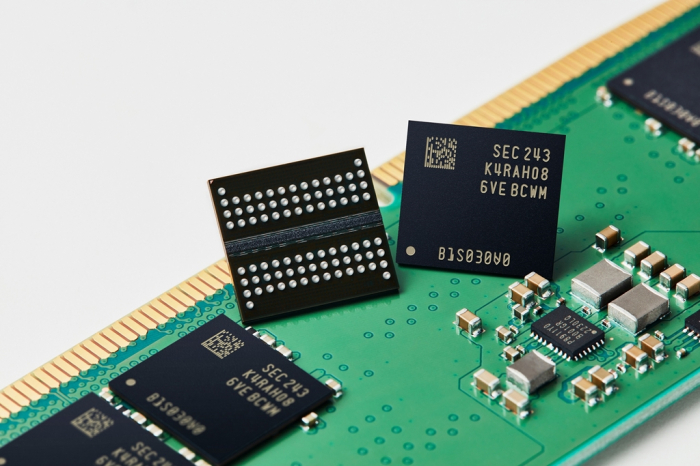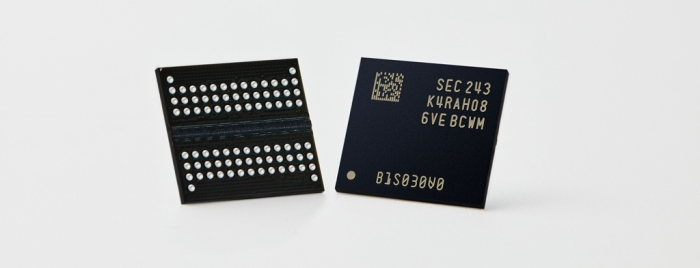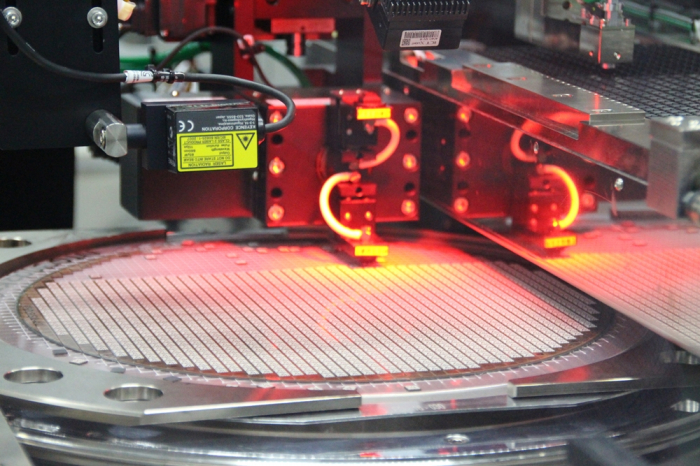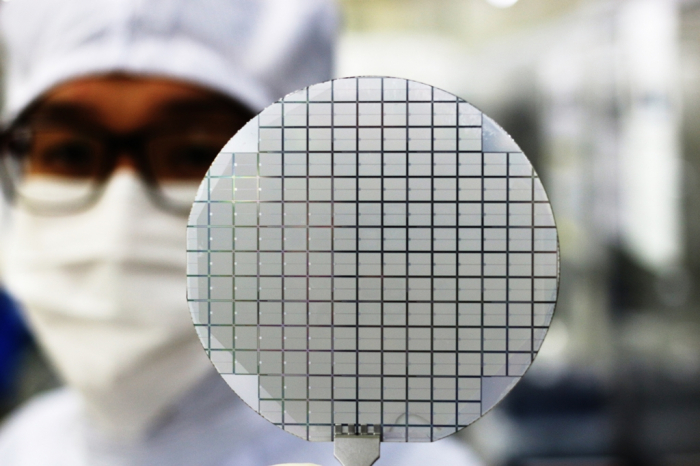Korean chipmakers
Samsung rolls out industry’s finest 12 nm DDR5 DRAM chips
The market leader plans to expand its advanced DRAM lineup to prepare for an industry upturn
By May 18, 2023 (Gmt+09:00)
3
Min read
Most Read
LG Chem to sell water filter business to Glenwood PE for $692 million


KT&G eyes overseas M&A after rejecting activist fund's offer


Kyobo Life poised to buy Japan’s SBI Group-owned savings bank


StockX in merger talks with Naver’s online reseller Kream


Meritz backs half of ex-manager’s $210 mn hedge fund



Samsung Electronics Co. has begun mass production of 16 gigabit DDR5 DRAM chips, using the industry’s finest 12-nanometer process node, further widening its lead over rivals in chip processing technology.
Samsung, the world’s largest memory chipmaker, said on Thursday it has already proven the performance of the latest chip through a compatibility test with CPU maker Advanced Micro Devices Co.
Samsung said it will broaden its DRAM lineup built on cutting-edge 12 nm-class process technology as it continues to work with industry partners to support the rapid expansion of next-generation computing.
“Our latest DRAM reflects our continued commitment to leading the DRAM market, not only with high-performance and high-capacity products that meet computing market demand for large-scale processing but also by commercializing next-generation solutions that support greater productivity,” said Lee Joo-young, executive vice president and head of DRAM product & technology at Samsung.

The Suwon, South Korea-based company said the next-generation double data rate 5 chip made with the 12 nm tech – an industry first – boasts a data transfer rate of up to 7.2 gigabits per second (Gbps). At this speed, the hardware can transmit two 30 gigabyte (GB) ultra-high-definition movies in a second.
The 12 nm process technology improves power efficiency by consuming 23% less power than the previous 14 nm DRAM model, it said.
In the chipmaking process, nanometer refers to the circuitry size of the transistors that can be packed on a chip. The lower the nanometer number, the more advanced the technology, promising a faster computing speed, higher performance and lower power use.
DRAM makers, including Micron Technology Inc. and SK Hynix Inc., are largely using a 14 nm node to produce DDR5 DRAM chips.

OPTIMIZED FOR AI, SUPERCOMPUTING APPLICATIONS
Samsung said its latest chip is suitable for high-performance computing (HPC), data centers and artificial intelligence (AI) applications.
The development of 12nm-class process technology was made possible thanks to the use of a new high-κ material that helps increase cell capacitance, it said. High capacitance results in a significant electric potential difference in data signals, which makes it easier to accurately distinguish them.
The company said its latest 12 nm DDR5 chip also uses extreme ultraviolet (EUV) technology to improve wafer productivity by 20%.
Samsung applied the EUV technology to its DRAM production for the first time among DRAM makers in March 2020.
EUV is a chip fabricating technology that reduces the steps in multi-patterning and improves patterning accuracy on wafers, ensuring better semiconductor performance, greater yields and a shorter chip development time.

SET FOR A MARKET UPTURN
With its industry-leading technology, Samsung said it will prepare for an upcoming DRAM market upturn.
While most industry officials expect a meaningful chip industry rebound early next year, some analysts said chip prices and the overall market conditions could start improving in the latter part of this year.
According to market tracker Omdia, the global DRAM market is forecast to reach $44.3 billion this year, down 44.1% from the year prior.
But the market is expected to grow 15.3% in 2024, 49.1% in 2025 and 3.9% in 2027 to reach $98.33 billion at the end of 2027.
Samsung is the world’s top DRAM supplier with 42.7% market share. In the server segment, the largest consumer of DRAM chips, the company controls the lion’s share with 40%.
Write to Ik-Hwan Kim and Jeong-Soo Hwang at lovepen@hankyung.com
In-Soo Nam edited this article.
More to Read
-
 Korean chipmakersDRAM prices rebound on Samsung output cut; earlier recovery eyed
Korean chipmakersDRAM prices rebound on Samsung output cut; earlier recovery eyedApr 12, 2023 (Gmt+09:00)
3 Min read -
 Korean chipmakersSamsung unveils industry’s first 12 nm DRAM, compatible with AMD
Korean chipmakersSamsung unveils industry’s first 12 nm DRAM, compatible with AMDDec 21, 2022 (Gmt+09:00)
2 Min read -
 Korean chipmakersMicron’s entry into DDR5 market: A boon for Samsung, SK Hynix
Korean chipmakersMicron’s entry into DDR5 market: A boon for Samsung, SK HynixAug 30, 2022 (Gmt+09:00)
2 Min read -
 Korean chipmakersSamsung makes industry’s smallest 14 nm DDR5 chip with EUV technology
Korean chipmakersSamsung makes industry’s smallest 14 nm DDR5 chip with EUV technologyOct 12, 2021 (Gmt+09:00)
4 Min read -
 Korean chipmakersSamsung widens lead over rivals with industry’s first advanced DDR5
Korean chipmakersSamsung widens lead over rivals with industry’s first advanced DDR5Mar 26, 2021 (Gmt+09:00)
3 Min read
Comment 0
LOG IN


